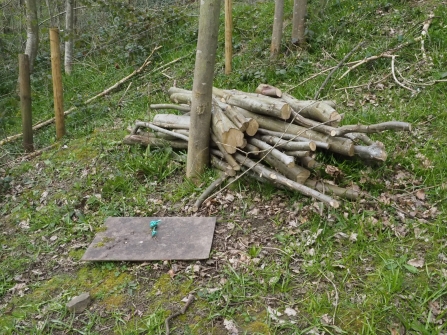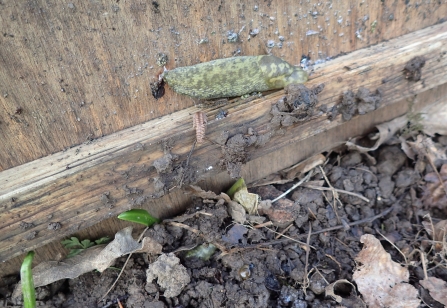Now I know that slugs are not everyone’s best friend but the species I’ve been looking at in my garden is not thought to be a pest of live plants. Instead it feeds on mould, algae, fungi, lichens, dead plants and is found in compost heaps and has a liking for pet food! Although once confined to woods, it is increasingly recorded from our gardens and near our houses and after dark I often find it on the ground beneath my bird feeders scavenging for tit bits.
What lives beneath?
Green cellar slugs by Rosemary Winnall

Refugia for wildlife by Rosemary Winnall
In the summer of 2017 my granddaughter and I made six refugia to place around the garden to attract creatures and to record what we found. We cut some marine plywood boards and glued beading along two sides so if they were dropped accidentally they were less likely to hurt anything lurking beneath. Since then we’ve had a lot of fun checking what was present and filling in our record sheets, noting woodlice, centipedes, millipedes, snails, slugs, beetles, ants, earwigs, worms, field voles, toads and slow-worms.
We did a round of the refugia on 29th February 2020 and under Board 4 we photographed three large green cellar slugs (Limacus maculatus) snuggled up together. I was reminded of the photograph I’d taken six months earlier of three such slugs under the same board on August 31st 2019 and this raised a few questions. Could they be the same three we wondered? Is it possible to recognise individual slugs from their body markings? When they go out to feed at night, how far do they travel before returning to their daytime refuge? How do they find their way back? Where do they go when it is very cold or very dry?

Green cellar slug by Rosemary Winnall
Now that we are in lock-down I’ve been checking this board every few days and found that these three slugs have been present on each occasion up until 31st March 2020 when only one slug was evident. Perhaps this was because the ground was drying out again after the winter rains. But then I spotted a second slug half-buried in the ground beneath the board, which gave me a clue about where they might go to prevent dessication. More questions were posed. Where are they going to spend the spring? How long do they live? How many slug species show site fidelity?
For nature-lovers there are always more questions than answers, but when the weather is warm and damp I shall be out with my torch at night to see if I can spot my 3 Green Cellar Slugs eating their breakfast!

